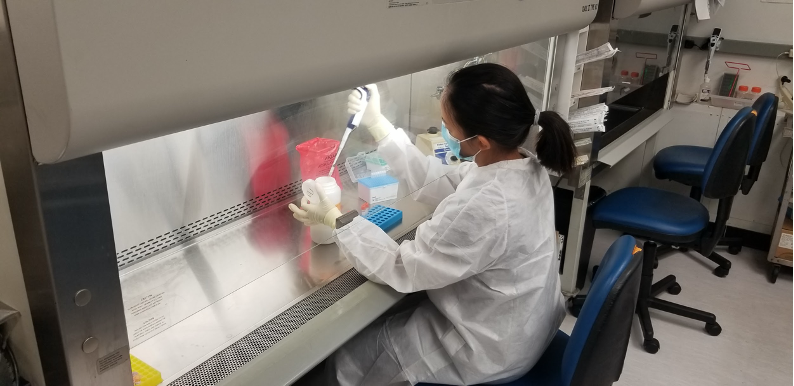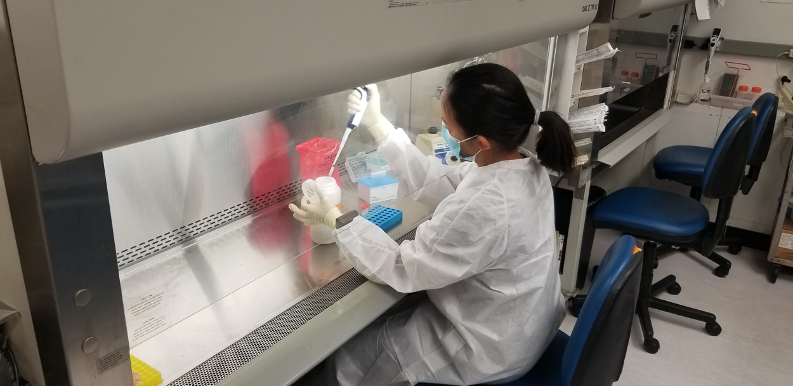
A technician at LA County Sanitation District aliquoting wastewater with known SARS-CoV-2 prior to RNA extractions using the Quick-RNA Fecal/Soil Microbe Microprep Kit.
In Los Angeles County, few resources are as precious to and connected with residents as water. In addition to being necessary to civil success in a desert, the contents of the county’s water tell the story of every life that touches it.
The Los Angeles County Sanitation District (LACSD) works to protect and monitor Los Angeles County’s water supply. 580 million gallons of wastewater are processed each day at four major LACSD water reclamation plants. Water that receives primary and secondary treatment is pumped out through deep ocean pipes. But, most of LACSD’s facilities also perform a tertiary treatment to generate water for irrigation and to be released into rivers for reuse.
COVID-19 has added to the scope of LACSD’s water reclamation mission. Not only does the department have to ensure reclaimed water is free of SARS-CoV-2, but monitoring of SARS-CoV-2 RNA levels in wastewater could help identify communities at risk for widespread infection.
“We are just trying to do our part. Everyone has been affected in some way by this pandemic, so when we realized that this work could help in making our communities safe again, it was a pretty easy decision.”
LACSD had four major goals. The first two were to develop a method to quantify SARS-CoV-2 RNA in wastewater, and then to use that method on both wastewater coming to treatment plants and the effluent water leaving them. Then they had to determine if any discovered SARS-CoV-2 signals were coming from the infectious virus. Finally, LACSD had to monitor wastewater over time to determine if this data could be used to detect community SARS-CoV-2 infections in near-real-time.
“We are just trying to do our part. Everyone has been affected in some way by this pandemic, so when we realized that this work could help in making our communities safe again, it was a pretty easy decision,” says Ryan Reinke, Research Scientist at LACSD.

The project required an RNA purification kit that had superior inhibitor removal and allowed small elution volumes. The Quick-RNA Fecal/Soil Microbe Microprep Kit met all the requirements and was selected for the project.
“The ability to elute in a smaller volume allows us to concentrate the RNA from the wastewater without having to concentrate the wastewater itself which would lead to higher variability and loss of viral RNA,” says Reinke. “Our experience with the kit is it produces very consistent and reproducible data while obtaining very high levels of RNA recovery.”
LACSD’s innovative protocol made use of the Quick-RNA Fecal/Soil Microbe Microprep Kit which is able to purify total RNA including small RNAs (>17 nt) from various soil, sludge, sediment and/or fecal samples in a simple, reliable, and rapid manner.
In these challenging times where scaling up COVID-19 testing is necessary, wastewater monitoring serves as the ideal method for researchers to get a better scope of the number of infected individuals in a region.
Influent wastewater was collected daily by Los Angeles County Sanitation District from April 13th to August 19th at their San Jose Creek Water Reclamation Plant (SJC) as well as a Joint Water Pollution Control Plant (JW). Each site was sampled for 5 ml of influent stored in a 15 ml conical tube.

Each day, a total of six (250 µl) aliquots were taken from the respective 5 ml samples and immediately stored in 750 µl of DNA/RNA Shield. DNA/RNA Shield inactivates viruses and preserves nucleic acid at room temperature for 30 days; this transport medium is being used in over 12 FDA EUA authorized SARS-CoV-2 testing workflows. Three aliquots were stored in a -80°C freezer as back-ups while three replicate RNA extractions were performed on the inactivated wastewater for a total of six extractions. RNA purification was performed using Zymo Research’s Quick-RNA Fecal/Soil Microbe Microprep kit.
CDC guidelines were followed for reverse transcription and qPCR amplification of the N1 and N2 regions of the SARS-CoV-2 genome. The viral copy number was then plotted against a 7-day average of new cases of SARS-CoV-2 in the Los Angeles county region (Fig. 1)1,2.
While the SARS-CoV-2 RNA signal was found in the wastewater, the treatment facilities were effective in eliminating the virus, and the reclaimed water is safe to use. The data also suggests that this type of viral monitoring could be a quick and cost-effective way to identify COVID-19 “hot spots” in the community so that resources can be rapidly directed towards those areas to manage and contain the virus’ spread.
LACSD’s COVID-19 wastewater monitoring project has not only proven to be a way to detect and trace potential outbreaks, but it could serve as a blueprint for other wastewater facilities in monitoring viral diseases when communities face infectious threats in the future. In an ever-increasingly connected world, global pandemics will likely continue to loom as public health threats. However, with proper safeguards, policies, and viral surveillance programs in place, communities can be more prepared than ever before – thereby protecting local economies, reducing healthcare costs, and most importantly, saving lives.
Thank you Zymo Research for contributing this story.
Please click HERE to see the original post.